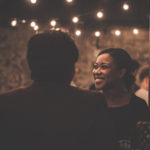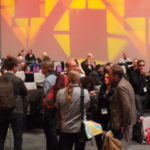
From the very beginning, our goal was to be the Southeast’s interactive festival,” Stanfield Gray said, sitting in a coffee shop in downtown Charleston, S.C., a month after he launched DIG SOUTH. The conference and expo, focused on the Southeast’s burgeoning digital, creative, and technology industries, was held at the College of Charleston TD Arena on April 12-14. “South by Southwest is in Austin, which is a long way from here,” Gray said, “and then there are other festivals that are very specific — one is all about coding, mobile, or blogging — but there didn’t seem to be a big, broad festival in the Southeast that mixed content creative with platform creative.”
Gray had been thinking about DIG SOUTH for a while. But he kicked his plan into high gear two years ago, when a medical scare — a benign tumor — delivered a “wake-up call.” Not long after, he attended the Ad Age Digital Conference in New York City. “I was inspired by the presenters from Foursquare, Virgin Atlantic, HuffPost, Coca-Cola, and Twitter,” said Gray, who today is director of strategic communications at the College of Charleston and music editor for Charleston magazine. “But what I realized was, I didn’t think anybody I met there was necessarily smarter or had more vision than the people I knew in Charleston and the Southeast. They just had more access to capital and lived in urban environments where they had more talent to draw from to build their companies.”
Charleston and the surrounding Southeastern region have been gaining traction as a hub for digital innovation for some time now. In 2011, Fast Company spotlighted the city as “Silicon Harbor,” and in recent years, companies like Amazon’s CreateSpace, Twitter, and Google have opened offices there. Lesser-known tech companies like PeopleMatter, BenefitFocus, and Blackbaud also call the city home.
Even with that homegrown infrastructure to draw on, Gray’s plan to create a Southeastern version of SXSW wasn’t without risks. Not only did he and his wife, Sunny, fund the entire for-profit venture themselves, but the festival’s theme — an umbrella of all things digital, all things creative, and how they overlap — was by no means a sure thing. “It made it difficult to sell the first year,” Gray said. “I had to take a huge leap of faith to pull off DIG SOUTH. I have a high degree of risk tolerance and the spirit that you only live once, so why not dive into the deep end?”
‘For Me, That Was Symbolic’
But as Gray reached out for support and input, building a large advisory committee of experts like Rob Savoy, national contracts manager for festival productions with the New Orleans Jazz & Heritage Festival; Baron Jordan, global IT leader for the Coca-Cola Company; and Ernest Andrade, executive director of Charleston Digital Corridor, he found a community ready and eager to support DIG SOUTH. Gray’s vision of bringing together all aspects of the industry resonated with startups and veteran organizations like CNN, Face-book, and Twitter, all of which were represented at this year’s festival.
To keep its young, on-the-brink audience engaged, Gray crafted an educational conference that went beyond traditional keynote presentations and panel discussions — although DIG SOUTH had those as well. Interactive sessions that allowed the audience to co-create the experience and connect more intimately with each other took precedence. “Speed Dating for Startups” let attendees chat up presenters in a 45-minute, round-robin-style conversation about whatever they wanted; while the “Straight to Video” workshop let them show their YouTube or Vimeo videos to experts and get one-on-one advice on production, editing, and other topics. And, steering away from hyper-specific education tracks, Gray designed all of DIG SOUTH’s sessions to include an array of experts representing the entire spectrum of the audience — including a panel with an app developer, a software developer, and a nutritionist who uses apps in her work with clients.
In addition to showcasing that the Southeast is a hotbed for innovation with speakers like Katie Caperton, editor-in-chief of Atlanta-based HLNtv. com, Gray brought in success stories for inspiration. For example, speaker Holly Burns, content strategist at Facebook, was formerly an editor at Charleston magazine. “For me, that was symbolic,” Gray said. “If you can launch out of Atlanta, there’s no reason why the next Facebook or Twitter can’t be launched here in Charleston.”
Music + Mobile

Taking cues from SXSW, Gray supplemented DIG SOUTH’s conference and expo with the Sideshow — a compendium of music concerts, comedy acts, networking happy hours, and other nightly events. Performers were handpicked by Gray to represent all parts of the Southeast. Offbeat spaces in Charleston such as the Redux Contemporary Art Center, a hybrid gallery and studio space for artists, and The Alley, a part-restaurant, part-sports bar, part-bowling alley, were used as venues.
For Gray, the Sideshow was an effort to demonstrate how thinking creatively and experiencing creativity are mutually beneficial. “Steve Jobs was a software developer, but the iPod wouldn’t exist without music and video content to put on it,” Gray said. “He was obviously inspired by music and film — he also founded Pixar. So to me it’s natural to put these two together.
“Some people like [these conferences] to be more like a workshop — let’s drill down and learn how to code. But that wasn’t our mission. I’ve always loved the idea of bringing different types of people together and exploring big ideas.”
DIG SOUTH V2014
Total attendance for DIG SOUTH was 3,162, with 454 people attending the conference portion (about 50 more than Gray’s goal) and 55 exhibitors participating in the expo. Sunday’s program was slower than expected, so Gray plans to add another day and move to a Wednesday-Saturday schedule in 2014.
Finding a supportive network, Gray said, was key to launching an event on the scale of DIG SOUTH. “It’s essential to get community buy-in on multiple levels, from business and government leaders, universities, creative community groups, the local chamber and others,” Gray said.
“But it’s equally important to trust your vision and not allow it to be diluted by the compromises of commit tee thinking. With DIG SOUTH, keen attention to the quality of content and the participant experience remained our guideposts. We were very careful not to compromise on those two fronts on every level, from the selection of presenters and exhibitors down to the music and every morsel of food.”
Coming up with new ways to reinvent the ubiquitous happy-hour event is a never-ending challenge for planners. So instead of hosting the same-old cocktail reception in a hotel bar or ballroom, DIG SOUTH’s Stanfield Gray essentially turned the entire city of Charleston into a revolving happy hour.
Studio Strut, as it was called, served as the kick-off to DIG SOUTH, lasting from 4 to 6 p.m. on the first day of the festival. Twelve area businesses, from ad agencies to website-design companies, opened their doors, served drinks, and invited in anyone who was interested in learning more about what they do — whether they were a conference attendee or not.
“Initially, I went to companies who wanted to participate in the Strut with the idea of grouping them together at a bar,” Gray said. “We would advertise, ‘If you want to meet people at these four companies, go to this bar.’ But Robert [Prioleau, partner and strategy director] at Blue Ion [website-design firm,] thought it would be a cool concept to bring attendees into the studios, let them see the actual workspaces, and bounce around between them.”
Since most of the participating companies were located within walking distance of each other in downtown Charleston, the end result was a progressive happy hour that mixed curious locals, out-of-town presenters and speakers, and festival participants in a casual, come-and-go-as-you-please atmosphere.
In all, Gray estimates that close to 500 visitors participated in the Strut, although an official tally isn’t available. “Studio Strut was also an opportunity [for us] to offer another free event,” Gray said. “For a lot of people, especially entrepreneurs in their early 20s, they can’t afford [festival tickets]. This was a way for them to get out and meet people.”



